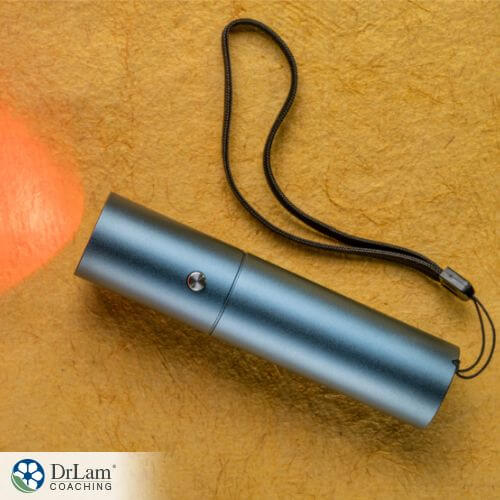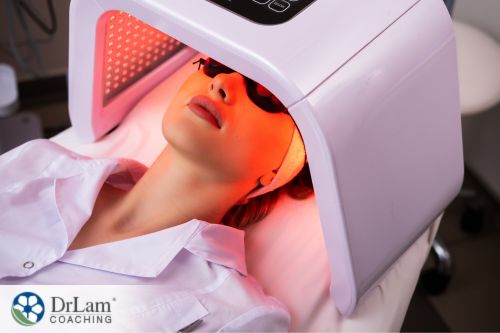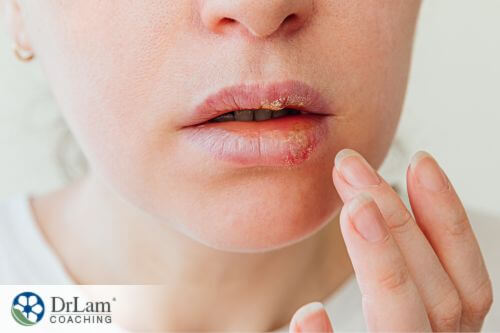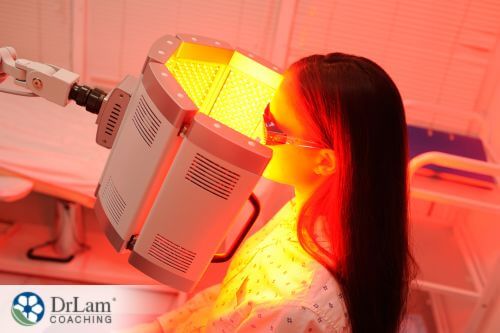 Data by the World Health Organization indicates that the majority of the world’s population has at least one or more herpes virus infections. Herpes is known as a commonly transmitted disease in the U.S. that has the potential to cause harmful and undesired effects on the human body. In most instances, people are primarily infected in childhood, but reactivation of latent herpes viruses can occur as a result of issues like infection, environmental factors, stress, and certain disorders. This condition may cause patients discomfort and pain. While conventional medicine exists to help ameliorate symptoms, red light therapy could potentially offer a natural way to address herpes. For more details on red light therapy for herpes, keep reading.
Data by the World Health Organization indicates that the majority of the world’s population has at least one or more herpes virus infections. Herpes is known as a commonly transmitted disease in the U.S. that has the potential to cause harmful and undesired effects on the human body. In most instances, people are primarily infected in childhood, but reactivation of latent herpes viruses can occur as a result of issues like infection, environmental factors, stress, and certain disorders. This condition may cause patients discomfort and pain. While conventional medicine exists to help ameliorate symptoms, red light therapy could potentially offer a natural way to address herpes. For more details on red light therapy for herpes, keep reading.
Billions of people across the globe experience oral or genital herpes. The Herpes Simplex Virus (HSV) falls into two categories:
Some common symptoms of herpes include:
While there is no known cure for herpes, there are a few approaches for addressing the condition. You can take antiviral medicine to reduce the length of outbreaks or avoid them altogether. Also, regular immunosuppressive therapy can be used to reduce the risk of partner transmission of the herpes virus.
Furthermore, today, red light therapy for herpes is another approach that is being applied to manage the condition. It’s a form of photobiomodulation.
Photobiomodulation is a process involving the absorption of red light energy to produce a chain of physiological effects at the cellular level. These physiological effects can be the improvement of mitochondrial Adenosine Triphosphate (ATP) production, a boost in cell signaling and growth factor synthesis, or the reduction of oxidative stress.
Red light therapy creates powerful light energy that penetrates an individual’s tissue to support healthy cell creation, renewal, and function. It can promote healing. Herpes is a sensitive condition and applying red light therapy can be highly effective. Red light therapy can aid the condition more quickly than some other methods, combining red and near-infrared (NIR) wavelengths. Before you begin red light therapy for herpes, however, consult with your healthcare provider.
Red light therapy is a type of non-invasive procedure that utilizes red LED light to address both cosmetic and medical skin conditions, from acne to wrinkles. It’s painless and typically low-risk.
 During the procedure, the area of your body that needs the therapy receives exposure to low levels of red light. This light impacts the mitochondria, which are energy generators in the cells in your body.
During the procedure, the area of your body that needs the therapy receives exposure to low levels of red light. This light impacts the mitochondria, which are energy generators in the cells in your body.
The molecule adenosine triphosphate (ATP) stores the energy the mitochondria generate. Over time, factors such as aging, illness, and lifestyle changes cause your mitochondria to produce less ATP. Red light therapy for herpes may boost healing in your body by stimulating the mitochondria to produce more ATP. As a result, this helps the cells in the body work more efficiently. This could be through new cell growth, for instance. Furthermore, red light therapy can also activate the cells in the body to accelerate the production of antioxidants. This can reduce levels of inflammation.
The procedure involves the use of a red light that can penetrate the body’s tissues. This particular type of wavelength (red light) allows for easier absorption by the areas of the cells in your body that capture light energy. As such, the cells can better utilize red light.
Red light therapy is often called low-level laser therapy (LLLT), or low-power laser therapy, because this form of laser therapy uses lower energy in comparison to other kinds.
According to an article in the Journal of Lasers in Medical Sciences, a large majority of reports confirm the therapeutic effects of LLLT on HSV-1 and HSV-2. It suggests that red light therapy for herpes shortens the symptomatic period, reduces inflammation, and diminishes pain, itching, and burning. Additionally, it decreases the rate and duration of recurrence and boosts remission time. Also, these effects appear possible because of the activation of the sanogenetic processes in the body and immune system modulation.
Furthermore, the article suggests that LLLT affects the pathological pathways of the herpesvirus infection. It stimulates cell organelles function (mitochondria, lysosomes, ribosomes) and greatly boosts the cell resistance to pathogens, like viruses. As such, the herpesvirus is unable to reprogram the functions of organelle cells which causes the cell to work for itself. Consequently, this can prevent its virulence.
Early studies related to the use of red light therapy for herpes indicate that it might be an effective way to address the condition.
A study in the Journal of Investigative Dermatology examined the effectiveness of low-intensity laser therapy for managing recurrent herpes simplex infection at the Department of Dermatology of the University of Vienna Medical School. In the study, the impact of low-intensity laser therapy (wavelength 690 nm, intensity: 80 mW per cm2, dose: 48 J per cm2) in 50 patients with recurrent perioral herpes simplex infection (at least once per month for more than 6 months) was up for evaluation. Also, in the randomized, double-blind placebo-controlled trial design, patients in the laser group were given irradiations daily for 2–52 weeks, while patients in the placebo group were given sham irradiations.
After completion of the therapy, the researchers concluded that 10 irradiations with low-intensity laser therapy greatly lowered local recurrence of herpes simplex infection. Additionally, since low-intensity laser therapy is safe and noninvasive, it might be an effective alternative to established therapeutic regimens for tackling herpes.
 In another study, published in the journal Clinical and Experimental Dermatology, UK researchers evaluated the the effectiveness of low-level light therapy using 1072 nm infrared light (using a light-emitting diode device) for addressing herpes simplex labialis. In a prospective, randomized, placebo-controlled, clinical trial, 87 patients with recurrent HSL were divided into two groups. Participants were given a 3-minute therapy with either 1072 nm infrared light therapy or placebo (sham) light therapy three times/day for 2 days. Neither the researchers nor the participants could tell the difference between the devices used for both groups since they were identical in appearance. Also, 1072 nm light is invisible to the human eye.
In another study, published in the journal Clinical and Experimental Dermatology, UK researchers evaluated the the effectiveness of low-level light therapy using 1072 nm infrared light (using a light-emitting diode device) for addressing herpes simplex labialis. In a prospective, randomized, placebo-controlled, clinical trial, 87 patients with recurrent HSL were divided into two groups. Participants were given a 3-minute therapy with either 1072 nm infrared light therapy or placebo (sham) light therapy three times/day for 2 days. Neither the researchers nor the participants could tell the difference between the devices used for both groups since they were identical in appearance. Also, 1072 nm light is invisible to the human eye.
The primary goal of the study was to evaluate the healing time for the HSL lesions to resolve completely and for the underlying skin to fully re-epithelialize. Furthermore, to a lesser extent, researchers also wanted to see how long it would take for lesions to crust. The research findings indicate that HSL lesions addressed with 1072 nm infrared light had significantly reduced healing time.
Red light therapy is available in two forms, one as an in-office procedure and two, through at-home devices. Through the U.S. Food and Drug Administration, several red light therapy devices are available for home use. Some of these red light therapy at-home devices come with instructions about use. For example, some commonly direct you to use them for 30-60 minutes, twice a day, for four or five weeks. However, a healthcare provider, such as a dermatologist may have more powerful red light therapy devices in the office.
The Red Light Therapy Band by Quantus, for instance, is an innovative device that you can use at home, at work, or on the go. It increases ATP energy production, reduces inflammation, oxygenates the blood, and aids in the production of cells. The Red Light Therapy Band’s pulsating effect stimulates collagen production and increases circulation by creating micro-tears that promote faster healing.
Herpes infections are more common in people suffering from Adrenal Fatigue Syndrome (AFS), which is the non-Addison's form of adrenal dysfunction, where the body's stress response cannot keep up with life's chronic stressors. Adrenal fatigue can lead to immune system dysregulation and chronic inflammation, which can lead to flair-ups of underlying infections like herpes. The condition can also be a vicious cycle with recurring outbreaks that can worsen stress.
Chronic inflammation is related to both herpes and AFS, stemming from stress that is characteristic of both conditions. The body's inflammation circuit of the NENeuroEndoMetabolic Stress Response is comprised of the immune system, gastrointestinal tract, and microbiome. It works to regulate inflammation in your body. Both conditions can cause the circuit to experience an imbalance, so it’s important to restore this balance. Red light therapy may help to reduce this inflammation.
According to current research findings, red light therapy for herpes is effective in reducing healing time and lowering the risk of recurrence of herpes simplex infection. Its healing actions are possible through its impact on the body’s mitochondria as discussed before.
However, to maintain the results from this light therapy, you might need to have one or two follow-up sessions per year. It’s best to follow the recommendation of your healthcare provider for the best results. Also, keep in mind that it’s unclear which patients will experience improvements and to what degree. As such, more research is needed.
 Red light therapy appears to be a safe procedure for most healthy adults. It’s a non-toxic procedure that does not use UV rays. Therefore, it doesn’t increase your risk of skin cancer. Also, there are no reports of any severe negative side effects, like inflammation, pain, or a recovery period that interferes with your daily life.
Red light therapy appears to be a safe procedure for most healthy adults. It’s a non-toxic procedure that does not use UV rays. Therefore, it doesn’t increase your risk of skin cancer. Also, there are no reports of any severe negative side effects, like inflammation, pain, or a recovery period that interferes with your daily life.
A study published in the Journal of Biophotonics looked at the safety of light-emitting diode (LED) red light on human skin. The research findings suggested that LED-red light is safe up to 320J/cm² for skin of color and 480J/cm² for non-Hispanic Caucasian people. According to the researchers, LED-red light may cause differential cutaneous effects, with darker skin being more photosensitive.
Since there is limited research on red light therapy, there might be safety considerations that are not yet in focus. These include long-term effects, overuse or misuse of red light therapy for herpes, and how it might affect individuals with certain conditions.
For anyone breastfeeding or pregnant, talk with your healthcare provider before starting any new procedure.
Red light therapy for herpes appears to be beneficial in the healing process. It can reduce pain and inflammation, boost lesion healing, shorten the length of herpes breakouts, and minimize discomfort, improving patients’ quality of life. However, this form of light treatment has its limitations. It’s not a herpes cure and cannot eliminate the virus from your body entirely.
Research findings related to red light therapy suggest that this may be a promising alternative for herpes healing. It appears effective in minimizing the severity and viral potency of herpes breakouts, along with speeding the healing process. It’s a safe and non-invasive way to manage this common condition.
If you would like to use red light therapy to address herpes symptoms and possibly prevent future outbreaks or reduce recurrent outbreaks and severity, talk with your healthcare provider about the healing powers of red light therapy.
Couturaud, Virginie, et al. "Reverse Skin Aging Signs by Red Light Photobiomodulation." Skin Research and Technology, vol. 29, no. 7, 2023, p. e13391. https://doi.org/10.1111/srt.13391
Dougal, G., and S. Y. Lee. "Evaluation of the Efficacy of Low-Level Light Therapy Using 1072 nm Infrared Light for the Treatment of Herpes Simplex Labialis." Clinical and Experimental Dermatology, vol. 38, no. 7, 2013, pp. 713-718. https://doi.org/10.1111/ced.12069
Jagdeo, J., et al. "Safety of Light Emitting Diode-Red Light on Human Skin: Two Randomized Controlled Trials." Journal of Biophotonics, vol. 13, no. 3, 2020, e201960014. https://doi.org/10.1002/jbio.201960014
Moskvin, Sergey V. "Low-Level Laser Therapy for Herpesvirus Infections: A Narrative Literature Review." Journal of Lasers in Medical Sciences, vol. 12, 2021. https://www.ncbi.nlm.nih.gov/pmc/articles/PMC8558700/
Schindl, Andreas, and Reinhard Neumann. "Low-Intensity Laser Therapy Is an Effective Treatment for Recurrent Herpes Simplex Infection. Results from a Randomized Double-Blind Placebo-Controlled Study." Journal of Investigative Dermatology, vol. 113, no. 2, 1999, pp. 221-223. https://doi.org/10.1046/j.1523-1747.1999.00684.x
Red light therapy for herpes works by creating powerful light energy that penetrates an individual’s tissue to support healthy cell creation, renewal, and function. It can promote herpes healing by treating, preventing, and shortening herpes outbreaks. It minimizes the severity and viral potency by acting on the body's mitochondria.
